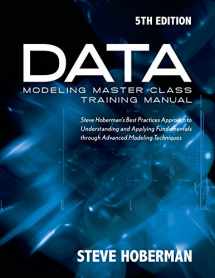
Data Modeling Master Class Training Manual 5th Edition: Steve Hoberman’s Best Practices Approach to Developing a Competency in Data Modeling
ISBN-13:
9781935504887
ISBN-10:
1935504886
Edition:
Fifth
Author:
Steve Hoberman
Publication date:
2014
Publisher:
Technics Publications
Format:
Paperback
328 pages
FREE US shipping
Book details
ISBN-13:
9781935504887
ISBN-10:
1935504886
Edition:
Fifth
Author:
Steve Hoberman
Publication date:
2014
Publisher:
Technics Publications
Format:
Paperback
328 pages
Summary
Data Modeling Master Class Training Manual 5th Edition: Steve Hoberman’s Best Practices Approach to Developing a Competency in Data Modeling (ISBN-13: 9781935504887 and ISBN-10: 1935504886), written by authors
Steve Hoberman, was published by Technics Publications in 2014.
With an overall rating of 4.0 stars, it's a notable title among other
books. You can easily purchase or rent Data Modeling Master Class Training Manual 5th Edition: Steve Hoberman’s Best Practices Approach to Developing a Competency in Data Modeling (Paperback) from BooksRun,
along with many other new and used
books
and textbooks.
And, if you're looking to sell your copy, our current buyback offer is $0.3.
Description
This is the fifth edition of the training manual for the Data Modeling Master Class that Steve Hoberman teaches onsite and through public classes. This text can be purchased prior to attending the Master Class, the latest course schedule and detailed description can be found on Steve Hoberman's website, stevehoberman.com.
The Master Class is a complete data modeling course, containing three days of practical techniques for producing conceptual, logical, and physical relational and dimensional and NoSQL data models. After learning the styles and steps in capturing and modeling requirements, you will apply a best practices approach to building and validating data models through the Data Model Scorecard. You will know not just how to build a data model, but how to build a data model well. Two case studies and many exercises reinforce the material and will enable you to apply these techniques in your current projects.
Top 10 Objectives:
The Master Class is a complete data modeling course, containing three days of practical techniques for producing conceptual, logical, and physical relational and dimensional and NoSQL data models. After learning the styles and steps in capturing and modeling requirements, you will apply a best practices approach to building and validating data models through the Data Model Scorecard. You will know not just how to build a data model, but how to build a data model well. Two case studies and many exercises reinforce the material and will enable you to apply these techniques in your current projects.
Top 10 Objectives:
- Explain data modeling components and identify them on your projects by following a question-driven approach
- Demonstrate reading a data model of any size and complexity with the same confidence as reading a book
- Validate any data model with key "settings" (scope, abstraction, timeframe, function, and format) as well as through the Data Model Scorecard
- Apply requirements elicitation techniques including interviewing and prototyping
- Build relational and dimensional conceptual and logical data models, and know the tradeoffs on the physical side for both RDBMS and NoSQL solutions
- Practice finding structural soundness issues and standards violations
- Recognize when to use abstraction and where industry data models can give us a great head start
- Use a series of templates for validating requirements and for data profiling
- Evaluate definitions for clarity, completeness, and correctness
- Leverage the Data Vault and enterprise data model for a successful enterprise architecture.


We would LOVE it if you could help us and other readers by reviewing the book
Book review

Congratulations! We have received your book review.
{user}
{createdAt}
by {truncated_author}


